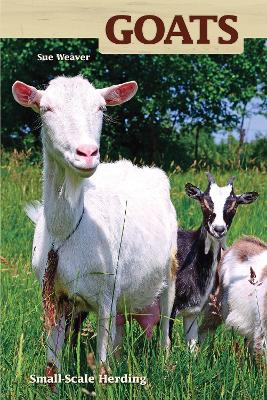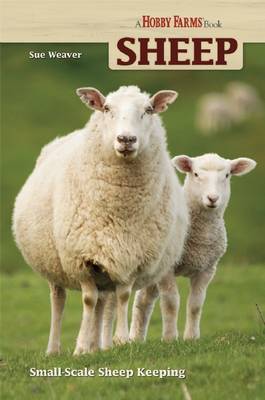Hobby Farms
3 total works
Hobby Farms Chickens: Tending a Small-Scale Flock for Pleasure and Profit is geared toward the hobby farmer looking to begin his or her own flock of chickens on a small farm or even backyard. Author Sue Weaver, who keeps various exotic breeds and countless barnies on her farm, is an expert on all things livestock and an avowed chicken fanatic. This photo-filled guide begins with "Chickens 101" and details the physiology of chickens, members of the Phasianidea family, providing beginning hobby farmers with a basic education in the chicken's unique physical makeup (from wings and feathers to beaks and digestive tracts), behavior, mating, and its unexpected high intelligence. The author offers advice on choosing the right types of chickens to get started: meat, egg, or dual purpose, or maybe even "just for pets." The book is an excellent resource for selecting which breed of chicken is best for the hobby farmer, based on the birds' traits, such as aggression, personality, noise factor, tolerance for heat, confinement, cold, etc.
Chickens also provides information on selecting or building a suitable chicken coop for the hobby farmer's brood, outlining the basic requirements (lighting, ventilation, flooring, waterers, insulation, safety, and so forth). A detailed chapter on feeding chickens offers essential guidance on nutrition, commercial feeds, supplements, and water requirements. For the chicken hobby farmer looking to start with a clutch of baby chicks (from his own hen or an outside source), the author provides excellent info on incubators and hatching as well as all of the accommodations and preparation required for hens in the nest box. A chapter on selling eggs and broilers provides timetables, requirements, and dos and don'ts to get a hobby farmer's business off on the right foot. All chicken keepers will find the chapter on health of particular value, with expert advice on preventing common problems and dealing various maladies and diseases. Much detailed information about all of the topics in the book is encapsulated in sidebars. A glossary of over 125 terms plus a detailed resource section of chicken and poultry associations, books, and websites complete the volume. Fully indexed.
Chickens also provides information on selecting or building a suitable chicken coop for the hobby farmer's brood, outlining the basic requirements (lighting, ventilation, flooring, waterers, insulation, safety, and so forth). A detailed chapter on feeding chickens offers essential guidance on nutrition, commercial feeds, supplements, and water requirements. For the chicken hobby farmer looking to start with a clutch of baby chicks (from his own hen or an outside source), the author provides excellent info on incubators and hatching as well as all of the accommodations and preparation required for hens in the nest box. A chapter on selling eggs and broilers provides timetables, requirements, and dos and don'ts to get a hobby farmer's business off on the right foot. All chicken keepers will find the chapter on health of particular value, with expert advice on preventing common problems and dealing various maladies and diseases. Much detailed information about all of the topics in the book is encapsulated in sidebars. A glossary of over 125 terms plus a detailed resource section of chicken and poultry associations, books, and websites complete the volume. Fully indexed.
Hobby Farms GOATS: Small-Scale Herding, written by hobby farmer and prolific author and columnist Sue Weaver, is an essential guide to the wonderful world of goats. This colorful guide discusses goats of all types, including dairy goats, used for milk and cheese; meat goats; fiber goats, prized for their mohair and cashmere; recreational goats, beloved by children for their great personalities and silliness; and brush goats, the lawnmowers of creative hobby farmers and suburbanites. Weaver offers excellent advice on how to purchase a goat: sensible and direct, she advises newcomers that while goats can be profitable, they should not rush in. Before the reader fills his backyard with a herd of goats, the author warns him or her to consider that while goats are "cute, personable, charming, and imminently entertaining...[they] are also destructive...mischievous, sometimes ornery, and often exasperating." The book lists the various breeds of goats commonly available as meat and dairy producers, carefully spelling out their advantages and drawbacks.
In the chapter on selecting a goat, the author instructs the reader to be aware of the overall health and soundness, and to consider such the animals' horns and teeth. The book also covers general care for a small herd of goats, including outdoor housing and feeding, general health care, and maintenance. For hobby farmers ready to dive into the world of reproducing their goats, there are chapters on breeding, mating, and "Bringing Kids into the World." All goat keepers will be enlightened by the information in the chapter on behavior and solving everyday problems with their often capricious caprines. Since the focus of the book is for hobby farmers, Goats also addresses how to make money from the small-scale herd, offering advice on managing, selling, and marketing goat-derived products. The book concludes with an extensive glossary of over 150 terms, an appendix of common goat diseases, and a resource section of useful goat-relevant books, websites, and associations. Fully indexed.
In the chapter on selecting a goat, the author instructs the reader to be aware of the overall health and soundness, and to consider such the animals' horns and teeth. The book also covers general care for a small herd of goats, including outdoor housing and feeding, general health care, and maintenance. For hobby farmers ready to dive into the world of reproducing their goats, there are chapters on breeding, mating, and "Bringing Kids into the World." All goat keepers will be enlightened by the information in the chapter on behavior and solving everyday problems with their often capricious caprines. Since the focus of the book is for hobby farmers, Goats also addresses how to make money from the small-scale herd, offering advice on managing, selling, and marketing goat-derived products. The book concludes with an extensive glossary of over 150 terms, an appendix of common goat diseases, and a resource section of useful goat-relevant books, websites, and associations. Fully indexed.
Hobby farmer Sue Weaver provides a perfect primer in Sheep, ideal for novice or experienced sheep keepers looking to expand their hobby farm with a flock of wooly wonders. Illustrated with instructive and beautiful color photographs and loaded with charts and sidebars, this Hobby Farms title will make even newcomers feel comfortable choosing, caring for, and even sheering and milking their own sheep. Weaver begins, "Be they pets or profit makers, sheep should be part of every small-farm scene. They are inexpensive to buy and keep, easy to care for, and relatively long lived, making them great investments." While sheep dotting a green meadow add beauty-and a possible tax write-off-to any pastoral setting, hobby farmers can choose whether their sheep will be sold as pets, used as providers of milk, cheese, or wool, or raised as livestock for their much sought-after mutton. As a subject, sheep have a fascinating history to tell, as Weaver does in the opening chapter "Sheep from the Beginning," but once we get through the mythology, biology, and anatomical lessons, the farming begins.
Sheep will assist the reader in buying the right sheep for his or her farm or land, based on availability, conformation, health, and so forth. The book offers practical advice, including how to move sheep from one locale to another (with a "ewe haul"). Sheep farming involves the housing, feeding, and guarding of the sheep, all detailed in the book. Weave discusses the use of fences, shelters, pens, and stalls as well as the purchase of the right hay. She also addresses the use of working dogs to control and guard the flock. Understanding sheep behavior is the subject of the chapter "Sheepish Behavior and Safe Handling," in which the author discusses flocking dynamics, fleeing instinct, and sheep body and vocal language, leading to practical advice about how to handle and move sheep safely and with minimal fuss. The old adage "A sick sheep is a dead sheep" may not hold completely true in modern times, but it does underscore how important the health of a flock is to a responsible sheep keeper.
The chapter "Health, Maladies, and Hooves" (and the appendix "A Glance at Sheep Afflictions") offers farmers vital information about vaccinations, parasites, and hoof care to be proactive in the flock's health. For hobby farmers interested in expanding their flocks, the chapter "The Importance of Proper Breeding" is a mini course in breeding and lambing, including bottle feeding, tail banding, and more. All of the joys of wool are captured in the chapter "Fleece: Shearing, Selling, Spinning," in which the author discusses the tools, skills, and fees required to fleece the flock. The chapter also discusses spinning your own wool and selling the fleece. The final chapter, "Mutton or Milk?" discusses the advantages and desirability of sheep's milk and the possible markets for milk, cheese, and meat. A glossary of over 100 terms, an extensive resources section (sheep-pertinent organizations, websites, and publications), and an index complete the volume.
Sheep will assist the reader in buying the right sheep for his or her farm or land, based on availability, conformation, health, and so forth. The book offers practical advice, including how to move sheep from one locale to another (with a "ewe haul"). Sheep farming involves the housing, feeding, and guarding of the sheep, all detailed in the book. Weave discusses the use of fences, shelters, pens, and stalls as well as the purchase of the right hay. She also addresses the use of working dogs to control and guard the flock. Understanding sheep behavior is the subject of the chapter "Sheepish Behavior and Safe Handling," in which the author discusses flocking dynamics, fleeing instinct, and sheep body and vocal language, leading to practical advice about how to handle and move sheep safely and with minimal fuss. The old adage "A sick sheep is a dead sheep" may not hold completely true in modern times, but it does underscore how important the health of a flock is to a responsible sheep keeper.
The chapter "Health, Maladies, and Hooves" (and the appendix "A Glance at Sheep Afflictions") offers farmers vital information about vaccinations, parasites, and hoof care to be proactive in the flock's health. For hobby farmers interested in expanding their flocks, the chapter "The Importance of Proper Breeding" is a mini course in breeding and lambing, including bottle feeding, tail banding, and more. All of the joys of wool are captured in the chapter "Fleece: Shearing, Selling, Spinning," in which the author discusses the tools, skills, and fees required to fleece the flock. The chapter also discusses spinning your own wool and selling the fleece. The final chapter, "Mutton or Milk?" discusses the advantages and desirability of sheep's milk and the possible markets for milk, cheese, and meat. A glossary of over 100 terms, an extensive resources section (sheep-pertinent organizations, websites, and publications), and an index complete the volume.


